Introduction
Therapist Statistics: The therapist is essential in promoting mental health and well-being, as therapists are trained professionals who offer counseling and psychotherapy services. These services are designed to assist people in managing a range of challenges, ultimately enhancing their overall mental health.
As modern life becomes more hectic, people encounter high work-related stress and increased social and financial issues, demanding the need for professional support. In 2023, approximately 4% of the global population was reported to have experienced an anxiety disorder, highlighting a significant portion of people affected by this mental health condition worldwide.
The demand for therapists has been steadily rising, driven by heightened mental health awareness, increasing stress levels, a growing need for mental health services, and the escalating prevalence of conditions such as anxiety and depression.
Editor’s Choice
- Research indicates that around 75% of people undergoing psychotherapy experience notable enhancements in their mental and emotional well-being.
- In 2024, more than 116 million people globally participated in online consultations with doctors.
- In 2024, 54% of people in the U.S. had participated in at least one telehealth appointment.
- Roughly 38% of the people in the U.S. had utilized telehealth services for either medical or mental health purposes.
- Younger adults aged 18 to 29 are more inclined to utilize telehealth services, with a usage rate of 66%, in contrast to 36% among older adults.
- Nearly 60% of people surveyed expressed a willingness to consider teletherapy for mental health support.
- In 2022, there was a 26% rise in the number of women receiving mental health treatment compared to the previous year, driven by increasing stress and mental disease cases.
- Teletherapy allows patients to receive therapy in the comfort of their own homes, providing a more private and less daunting atmosphere. This enhanced privacy can reduce the stigma linked to pursuing mental health services and motivate more individuals to seek assistance.
- More than 86% of people who engaged in teletherapy reported being satisfied with their experiences.
Types of therapists
- Marriage and family counselor
- Behavioral therapist
- Addiction therapist
- Divorce therapist
- Child Therapist
- Youth therapists
- Cognitive therapist
- Clinical therapist
- Exercise Therapist
- Cognitive-behavioral therapist
- Eating disorder therapist
- School therapist
- Social work therapist
- Social therapist
- Trauma therapist
- Nutritional therapist
- Psychodynamic therapist
- Dialectical behavior therapist
Compression Therapy Market Size
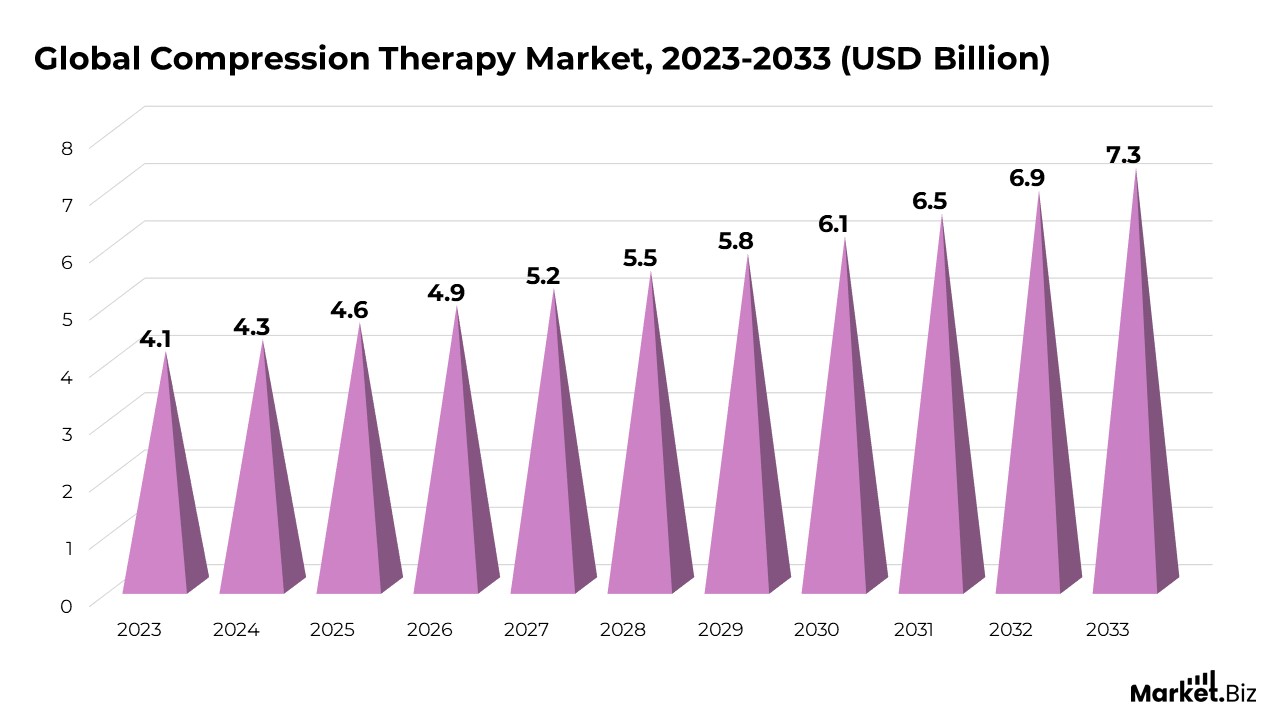
- As per Market.us, the global compression therapy market is projected to grow from $4.6 billion in 2025 to $7.3 billion by 2033, reflecting a compound annual growth rate (CAGR) of 5.9% during the forecast period from 2024 to 2033.
- The compression therapy market is witnessing significant growth, primarily driven by the rising prevalence of vein-related conditions, including deep vein thrombosis, leg ulcers, varicose veins, lymphedema, and blood clots, the increasing number of sports injuries, a growing volume of orthopedic procedures, and the rising incidence of chronic diseases.
- The compression bandages segment is projected to lead the compression therapy market, with a dominant revenue share of 38% throughout the forecast period. This growth is attributed to the widespread adoption of compression bandages for the treatment of edema and venous and lymphatic disorders.
- The varicose vein treatment segment is expected to hold the largest share of the compression therapy devices market, contributing to 34.5% of the revenue during the forecast period. This trend is driven by the increasing preference for compression therapy as an effective management option for varicose veins.
- The hospitals and clinics segment is anticipated to dominate the market, capturing a significant revenue share of 53% during the forecast period. This can be attributed to the growing adoption of compression therapy in healthcare facilities for the treatment of various vein-related and orthopedic conditions.
- North America is set to remain the leading region in the compression therapy market, accounting for 36.2% of the global market share in 2023. Region’s increased demand for continuous monitoring of vein-related conditions, a growing elderly population, rising obesity rates, and favorable government reimbursement policies contribute to North America’s market dominance.
(Source: Market.us)
General Therapist Statistics
- In 2023, there were over 198,811 therapists and more than 81,000 psychologists actively practicing in the U.S., reflecting the significant presence of mental health professionals across the country.
- There is a significant demand for therapists and psychologists in southern California and southern Arizona.
- As of March 2024, the therapists in the U.K. totaled approximately 283,000 people, encompassing a wide range of specialists such as physiotherapists, speech and language therapists, occupational therapists, psychotherapists, clinical psychologists, cognitive behavior therapists, and other psychological practitioners.
- In 2022, Italy reported a notable increase in the number of psychiatrists, with an additional 570 professionals (+4.98%) joining the field. As a result, the total number of psychiatrists in the country reached an all-time high of 12,019 in 2022, reflecting a significant expansion in mental health care capacity.
- In 2022, Australia’s mental health workforce included approximately 25,000 mental health nurses, 33,000 psychologists, 2,800 mental health occupational therapists, and 2,900 accredited mental health social workers.
- In 2023, Australia employed 4,300 psychiatrists, highlighting the diverse and expanding range of professionals involved in addressing mental health needs.
- France exhibits a notably higher demand for mental health support, with 45% of employees seeking assistance, well above the European average of 38%, driven by increasing awareness and a reduction in the stigma surrounding mental health.
- Mental health care in China has made some progress, but there is still a considerable gap to address. Currently, only 20 people per million in China have access to mental health services, compared to 1,000 people per million in the U.S., highlighting the ongoing challenges in bridging the mental health care divide between the two nations.
(Source: crossrivertherapy, Statista, Digital Minds Solutions, Asia Society Policy Institute, Australian Institute of Health and Welfare)
Demographics of Therapists
By Gender
- In the U.S., women account for approximately 70.4% of the therapist workforce, particularly dominating fields like counseling, family and marriage therapy, and social work.
- This gender imbalance has remained relatively steady over the years, largely influenced by cultural and societal expectations that align caregiving roles with women, thereby contributing to their predominance in mental health professions.
- Men represent about 24.7% of therapists in the U.S. While still a minority, the presence of male therapists is gradually increasing as mental health awareness expands and more men enter the field of counseling and therapy.
- The remaining 4.9% of therapists identify with an unspecified gender, contributing to the broader representation within the profession.
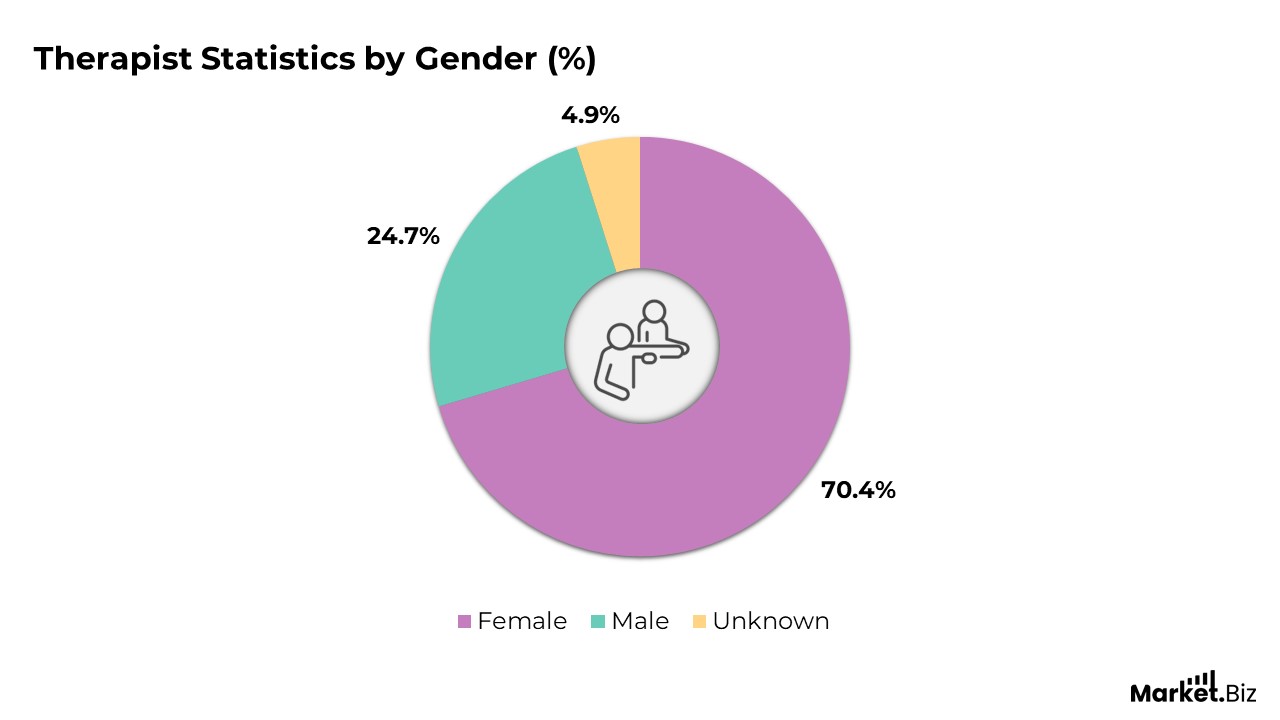
(Source: crossrivertherapy)
By Race
- White therapists constitute the dominant racial group in the therapist workforce, comprising 76.4%, highlighting their significant representation in the field.
- Asian therapists represent 10.6% of the profession, reflecting an expanding presence and contribution to the diversity within mental health care.
- The Hispanic or Latino therapist population stands at 6.3%, underscoring a growing trend toward increased racial diversity within the workforce.
- Black or African American therapists make up 4.1% of the therapist workforce, contributing to a more inclusive and representative profession.
- Therapists with an unknown racial background account for 2.2%, indicating a modest portion of practitioners without specified racial identification.
- American Indian and Alaska Native therapists represent 0.4% of the workforce, a small yet important demographic that adds to the overall diversity in the profession.
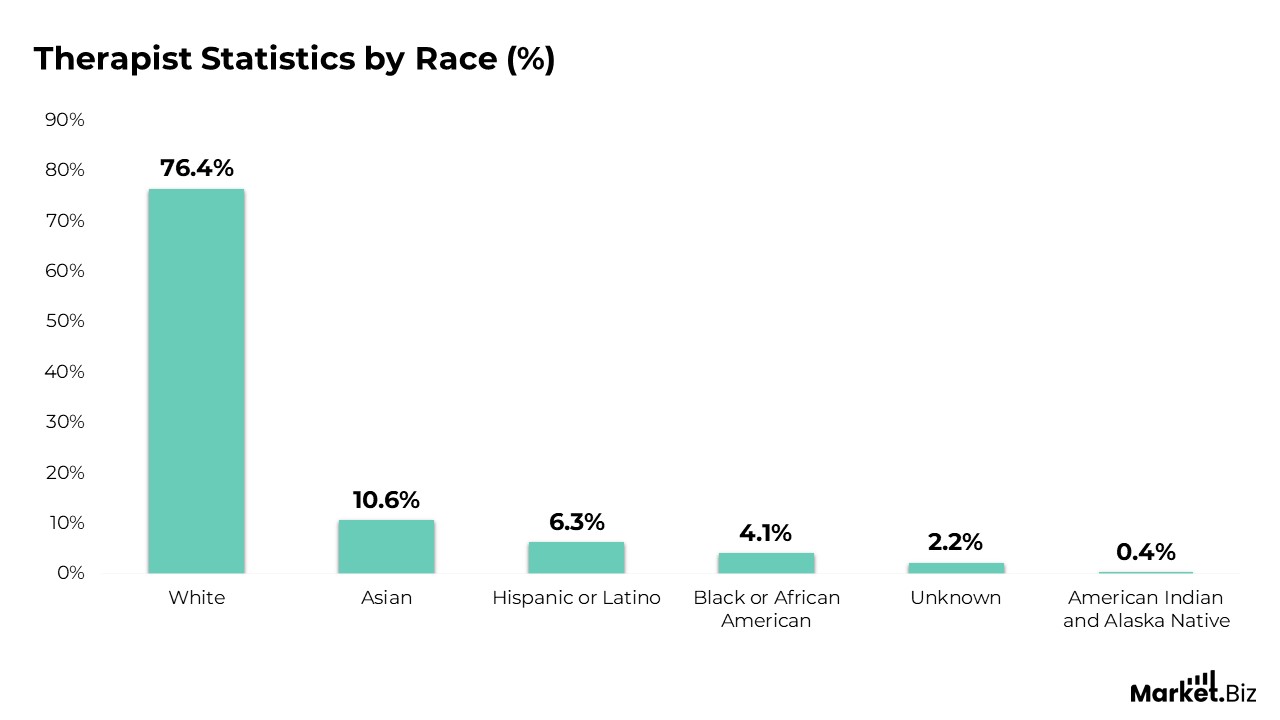
By Average Age
- People of Asian descent, irrespective of gender, represent the demographic with the highest average age, at 42 years, indicating a more mature workforce within this group.
- The demographic with an unspecified racial background exhibits the youngest average age, recorded at 33 years, suggesting a newer and potentially growing segment within the profession.
- Among the known ethnicities, Hispanic and Latino men have the lowest average age, with an average of just 38.5 years, reflecting a younger representation compared to other ethnic groups in the therapist workforce.
(Source: crossrivertherapy)
By Age Breakdown
- Approximately 14% of therapists fall within the 20-30 years age group, indicating a smaller yet emerging segment of early-career professionals entering the field.
- The 30-40 years age range comprises the largest proportion, 34%, signifying a substantial portion of the workforce in the mid-career phase with growing expertise and experience.
- A dominant 52% of therapists are aged 40+ years, reflecting a workforce largely composed of experienced professionals who bring a wealth of knowledge to the profession.
(Source: crossrivertherapy)
Degree Levels

(Source: crossrivertherapy)
What Types of Companies Do Therapists Work In?

Leading Sectors Hiring Therapists
- Healthcare organizations represent the largest employer of therapists, accounting for 36% of all available positions, driven by the rising demand for mental health and rehabilitation services, heightened awareness of mental health, an aging population, and the increasing prevalence of anxiety, depression, and chronic diseases.
- Non-profit organizations are the second-largest sector employing therapists, representing 21% of all available positions.
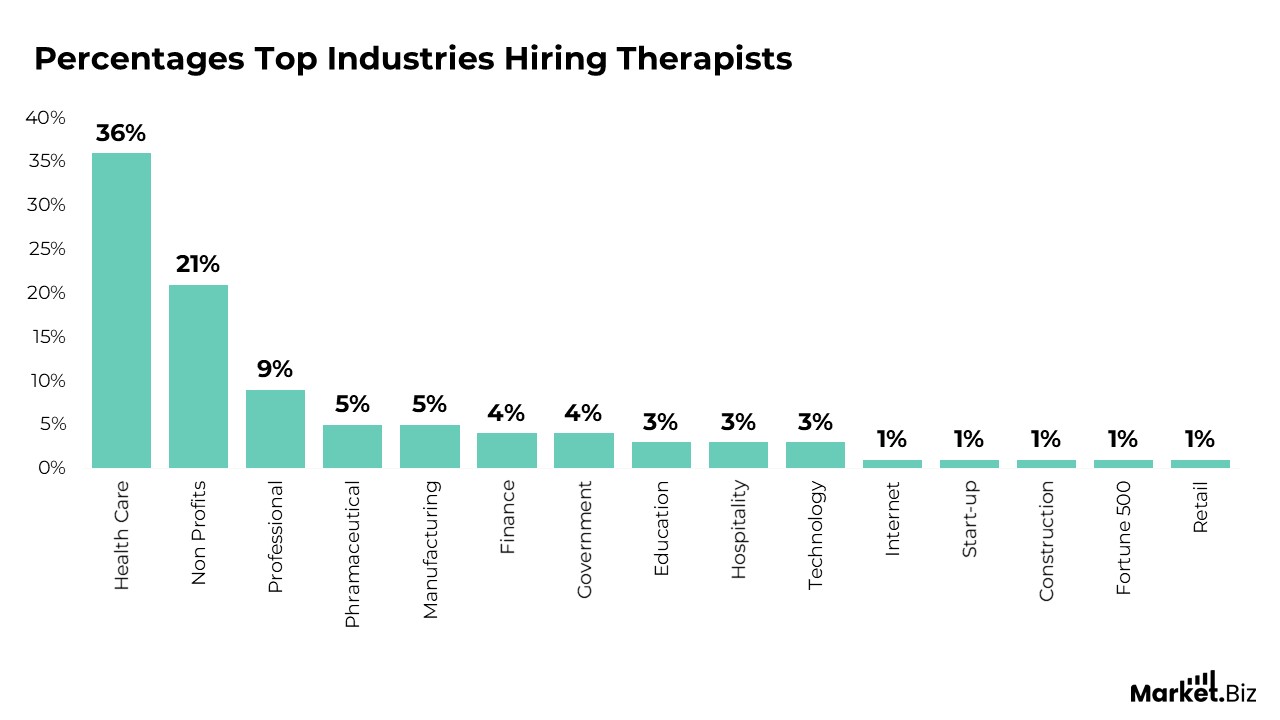
Most Preferred Therapy Method

Therapist Specializations in the U.S.
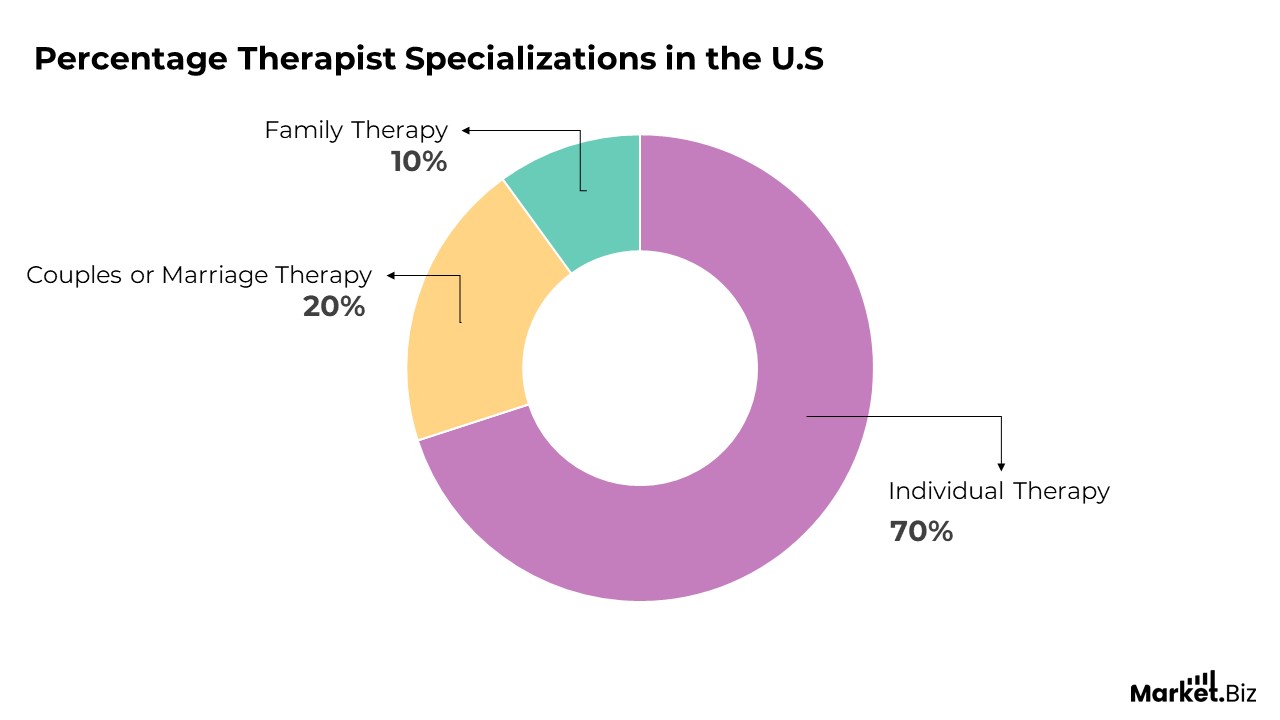
Prevalence of Mental Disease Statistics
Mental health disorders represent the most prevalent issue affecting people globally. Certain age demographics are more susceptible to mental health challenges than others.
- A 2022 report from China’s Mental Health Survey revealed that 6.8% of the population experienced depressive disorders, with clinical depression comprising about half of these cases, which equated to approximately 95 million people living with depression in China.
- Around 280,000 suicides occurred annually in China, with 40% of these individuals suffering from depression in 2022.
- In 2022, 42.9% of people in Australia aged 16–85 years had experienced a mental disorder at some point in their lives, highlighting the widespread impact of mental health conditions across a significant portion of the population.
- The severity of mental illness varies significantly among individuals. In 2023, approximately 57 million people in the U.S. were affected by mental health conditions.
- In 2022, 1 in 2 Australian adults experienced some form of mental ill-health and 3,000 suicides were reported, highlighting the severe impact of mental health issues on the population.

(Source: NIH, National Alliance of Mental Illness, Statista, University of St. Augustine for Health Sciences, Asia Society Policy Institute, Bayside Psychotherapy, Australian Bureau Statistics)
Chronic Obstructive Pulmonary Disease (COPD) Statistics
- In 2021, COPD was the fourth leading cause of death worldwide, accounting for around 3.5 million deaths that year due to tobacco exposure and air pollution.
- Almost 90% of deaths from COPD among people under the age of 70 take place in low- and middle-income countries (LMIC).
- In the U.S., the state of West Virginia has the highest prevalence of COPD, with more than 186,185 adults in the state diagnosed with the disease.
- An ERS survey revealed in 2020, there were 36.5 million Europeans detected with COPD. This number is expected to rise to 49.4 million people by 2050.
(Source: WHO, America Lung Association, NIH, Market.us, European Respiratory Society)
Depressive Disorders/Depression Statistics
Depression is a prevalent condition that can occur independently or as a comorbid issue alongside other diagnoses. As the incidence of major depressive disorder continues to increase, it will be essential to emphasize early intervention in the future.
- A significant gender disparity in the prevalence of depression worldwide. In 2023, approximately 5% of the global population experienced depression, with women being more likely to be affected than men.
- In 2022, Greece, Poland, and Cyprus had the highest percentage of adults at risk of depression in the EU, with 65% of their populations affected, compared to 55% across the EU27. This higher risk is due to economic instability, social stressors, and limited access to mental health care.
- Recent studies shown in 2022 revealed that depression rates among young people in India, with prevalence ranging from 31% to 57%, were driven by academic pressures, social media influence, rapid urbanization, and insufficient mental health awareness and support.
- In 2023, 21 million people in the U.S. suffered from a major depressive episode.
(Source: WHO, Rural Minds, Statista)
Therapy Effectiveness: Success Rate Insights
The effectiveness of therapy is greatly impacted by the quality of the relationship between the therapist and the client, the correctness of the treatment methods used, and the consistency of therapy sessions. These elements are crucial in determining both client satisfaction and treatment outcomes.
- In the management of Obsessive-compulsive disorder (OCD), noncompliance impacts approximately 31% to 65% of people.
- People with OCD who participated in ERP therapy saw a 47.8% reduction in anxiety, a 44.2% decrease in depression, a 37.3% drop in stress levels, and a 22.7% improvement in their overall quality of life.
- Approximately 2 in 3 people experience advantages from ERP therapy conducted through live teletherapy.
- On average, people with OCD experienced a 43.4% reduction in symptoms after participating in live teletherapy for exposure and response prevention (ERP) twice a week, followed by six weeks of weekly follow-up sessions.
(Source: NCBI, JMIR Publications)
Government Initiatives and Funding
Government and private organizations are launching initiatives, securing funding, and implementing therapy programs to enhance mental health care, thereby increasing the demand for specialized therapists. Some of the instances are as follows:
- In 2024, the UK Research and Innovation invested $3.36 million (€3.2 million) in funding for 24 projects to accelerate mental health services in the U.K.
- In 2024, the U.S. Department of Health and Human Services (HHS) allocated $240 million to launch and expand mental health and substance use disorder services across more than 400 community health centers, enhancing access to critical care for underserved populations.
- In October 2022, the Indian government launched the National Tele Mental Health Programme (NTMHP) initiative to create a comprehensive mental health service network, offering counseling and integrated medical and psychosocial interventions. The initiative received significant funding, with $15.41 million (₹120.98 CR) allocated for 2022-23, $16.20 million (₹133.73 CR) for 2023-24, and $10.76 million (₹90.00 CR) for 2024-25.
- (Source: Ministry of Health and Family Welfare, Innovate UK, HHS)
Recent Developments
New Product Launches
- In 2024, Viatris Inc. launched Unmind as part of its Elevate well-being initiative. Developed by psychologists, the platform helps people manage their mental health for healthier, happier lives.
- In April 2022, Now&Me, an India-based mental well-being company, launched Therapy&Me to support people by providing therapy and navigating life’s challenges.
Acquisitions and Mergers
- In April 2024, Optum acquired CARE Counseling, an outpatient mental health provider, with the aim of enhancing behavioral care delivery through a more integrated health system. This acquisition seeks to foster closer coordination between medical and behavioral health services.
- MentalWellness Group and TherapyHub have merged to form a comprehensive platform for online therapy sessions, with their combined annual revenues estimated to surpass $200 million.
Conclusion
Therapist Statistics – The mental health field is continuously evolving, requiring therapists to adapt to the changing needs of their clients while integrating new technological advancements. With a strong demand for their services, therapists play a vital role in improving the mental and emotional well-being of individuals, creating safe spaces, and tailoring their approaches to meet unique client needs.
Research consistently shows that psychotherapy significantly improves outcomes for conditions such as depression and anxiety, underscoring the value of therapeutic care. As awareness of mental health grows, the number of therapists has increased, further expanding the scope of services available.
Ultimately, the therapist profession is a dynamic, growing field that continues to evolve in response to both client needs and broader societal shifts in mental health understanding.
FAQ’s
There is a wide range of therapists providing mental health services, each with unique training and specializations. Some of the most common types include:
– Marriage and Family Therapists
– Psychologists
– Psychiatrists
– Counselors
– Music Therapists
– Social Workers
– Art Therapists
The need for therapists is steadily increasing. According to the Bureau of Labor Statistics, the employment of mental health counselors and marriage and family therapists is projected to grow by 25% from 2019 to 2029, a rate significantly higher than the average for all professions.
While data varies, the National Institute of Mental Health reports that about 19% of U.S. adults experienced a mental health condition in 2020, with roughly 50% of these individuals seeking mental health services.
Some of the most prevalent mental health challenges include:
– Depression
– Anxiety
– Relationship difficulties
– Trauma
– Addiction
Depression is among the most common mental health disorders in the U.S. In 2022, approximately 8.3% of adults reported having a major depressive episode. Of those, 32% had serious suicidal thoughts, compared to just 2% of individuals who did not experience a major depressive episode.
